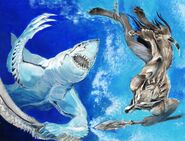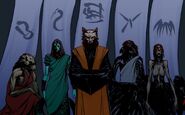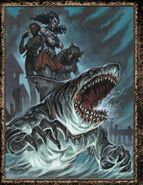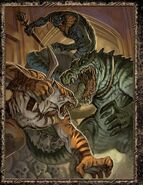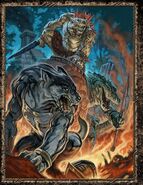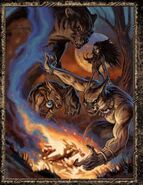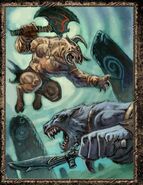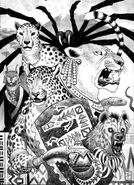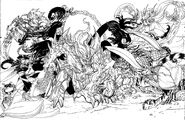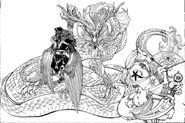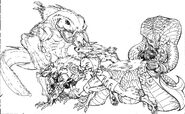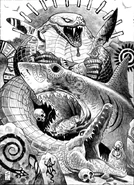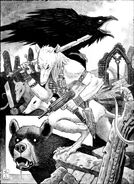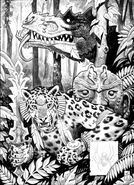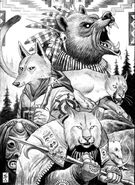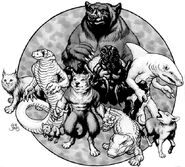
Garou glyph for "Fera"
Fera, or the Changing Breeds, are the races of shapeshifters of the World of Darkness, specifically Werewolf: The Apocalypse setting.
Overview[]
While the Garou were created by Gaia as her fangs and claws, to keep her safe, they were not her only children. She created many other breeds of shapeshifters and gave them each a task. Some have lost their way with time; others were forced from their roles by the Garou. Some have turned to serving only one aspect of the Triat, instead of Gaia as a whole.
The Children of Gaia, Silent Striders, Red Talons, Uktena, and Wendigo generally have the most contact with the Fera, and the most cordial relations with them. The Shadow Lords have regular contact with the Fera only through their Eastern branch, the Hakken. The Bunyip are sometimes mistakenly referred to as Fera - they are actually an extinct tribe of Garou, eradicated in the War of Tears.
Fera is the term most commonly used by the Garou themselves, to mean shapechangers of other races; other breeds have similar terms. The Garou used to use the Mokolé term Bête, but now only Garou who have contact with the Mokolé use that word – the Bastet use the word Killi instead, and the Ananasi refer to other changing breeds as Ovid, likewise, the Nagah tend to employ the term Khurah.
Most Fera have at least a strong distrust of the Garou, due to the actions of the Garou during the War of Rage.
Ajaba (werehyenas)[]

Symbol used by the Ajaba to describe themselves
- Main article: Ajaba
The werehyenas are Gaia's warriors in Africa, a continent without a wolf population. While the War of Rage did not reach Africa, the Ajaba were all but destroyed by infighting, their rivalry with the Bastet and, most significantly, the tyrannical Simba king, Black Tooth.
The survivors were exiled from their traditional homelands, but in recent years the Ajaba woman Kisasi rallied the Fera of Africa and formed an alliance known as the Ahadi; together, they defeated Black Tooth and revitalized Ajaba society.
In older source material, the werehyenas were considered a Bastet tribe. In the Revised edition, they are considered a separate type of Fera.
Ananasi (werespiders)[]

Symbol used by the Ananasi to describe themselves
- Main article: Ananasi
The werespiders are not children of Gaia, but rather children of Queen Ananasa, a powerful spirit child of the Weaver. They are considered alien and disturbing by other Fera, and not without reason: their animal form is a horde of creeping spiders, they possess no Rage, and they fuel their powers with blood stolen from humans. Their name is drawn from the West African trickster/god Anansi.
While "true" Ananasi serve the force of balance and harmony that the Weaver once represented, many have been corrupted by the Wyrm. These Wyrm spiders are in the east known as Kumo (or Goblin Spiders). Others fallen to the Corruptor are referred to as Antara, who have been removed from Ananasa's designs.
Apis (wereaurochs)[]

Symbol used by the Apis to describe themselves
- Main article: Apis
Wereaurochs or "Moon-bulls", the Apis were in charge of cultivation and agriculture, and known as the "Matchmakers of Gaia." They were driven to extinction by the Garou in the War of Rage.
Bastet (werecats)[]

Symbol used by the Bastet to describe themselves
- Main article: Bastet (WTA)
The werecats have many different tribes, like the Garou, though each claims a different species of wild cat. They are obsessed with secret knowledge and are always pursuing and hoarding it. Many are great magicians, others are great warriors, but they are rarely pack animals and generally work alone. Some of their tribes suffered greatly during the War of Rage.
Wyrm-corrupted Bastet are known as Histpah. One of their tribes' fall is portrayed in Apocalypse, later becoming the Hellcats.
Camazotz (werebats)[]

Symbol used by the Camazotz to describe themselves
- Main article: Camazotz
The Camazotz were werebats, Gaia's nocturnal and southern hemisphere messengers, counterparts to the Corax. They were almost wiped out during the War of Rage, but none survive today: the few who lived on in South America were destroyed by the Shadow Lords who arrived with the Spanish in the 1600s, and their fall saw their creation rites stop working, rendering the Camazotz of Australia the last of their kind.
The Xibalan were those werebats dedicated to the wyrmish aspect of their patron. They vanished when the last Camazotz died; however, it's hinted some are held in stasis and ready to serve the Wyrm again.
Bloodbats can be related to their Kinfolk, and via them their dark legacy continues.
Corax (wereravens)[]

Symbol used by the Corax to describe themselves
- Main article: Corax
The wereravens are Gaia's messengers, spies and scouts who patrol the skies, always on the lookout for danger. They are terrible chatterboxes and will tell what they have seen to any who care to listen. They escaped persecution in the War of Rage by aiding the Garou, and maintain the most cordial relations with the werewolves of all Fera.
Wyrm-tainted Corax are known as Buzzards and are created via the Rite of the Broken Wing.
Grondr (wereboars)[]

Symbol used by the Grondr to describe themselves
- Main article: Grondr
The wereboars were located in Northern Europe. Their task was to cleanse land; they were called Gaia's groomers. They were driven to extinction by the Garou during the War of Rage; their ancestor-spirits fell to the Wyrm and became the monstrous Skull Pigs.
Gurahl (werebears)[]

Symbol used by the Gurahl to describe themselves
- Main article: Gurahl
The werebears are Gaia's healers, tied to the Earth with a stronger bond than any other Fera. Many Garou believe the Gurahl are extinct, killed during the War of Rage when they would not give up the secret of restoring life to the dead. In truth, they entered a long sleep using a trick taught to them by the Mokolé, and have awoken in the modern world.
Hakken (werewolves)[]
- Main article: Hakken
Though related to the Garou as a branch of the Shadow Lords, these werewolves native to Japan underwent isolation from the rest of the world during the Edo period along with the rest of Japanese society. During this time, they almost entirely lost their ranks of the lupus breed (as wolves in the islands of Japan were almost entirely killed off during this period), and today are almost entirely composed of homids. This imbalance has wrought considerable change on their culture, making them markedly distinct from other Garou in their practices.
Kitsune (werefoxes)[]

Symbol used by the Kitsune to describe themselves
- Main article: Kitsune
The werefoxes are magicians and politicians, holding together the society of Asian shapeshifters. Unique among the Fera, the Kitsune are found only in the Beast Courts of the Middle Kingdom, living mostly in China and Japan. With Luna's blessing, the Kitsune also acted as assassins of the corrupt authorities in mortal society, as court wizards and thieves in order to protect the Heavenly Mandate.
Mokolé (werecrocodiles)[]

Symbol used by the Mokolé to describe themselves
- Main article: Mokolé
The werecrocodiles remember the age of the Dragon Kings, when terrible reptiles ruled the earth. They remember everything that has ever happened and keep that knowledge to themselves, only speaking to the properly respectful. Their Crinos forms more closely resemble dinosaurs or dragons than crocodiles, sometimes leading to them being called weredragons.
Fallen Mokolé are referred to as Mnetics and are perverting the memories of their kind.
Nagah (weresnakes)[]

Symbol used by the Nagah to describe themselves
- Main article: Nagah
Weresnakes that originated in India. Most (if not all) of the other changing breeds believe them to be dead, but they are very much still around. Serving as the "Judges of Gaia," the Nagah fill the role of both silent judges and hidden executioners for the Changing Breeds. Many of the Fera races believe the Nagah are extinct. Only Fera present in the Beast Courts are likely to know otherwise.
Nuwisha (werecoyotes)[]

Symbol used by the Nuwisha to describe themselves
- Main article: Nuwisha
The werecoyotes are Gaia's teachers, though like their totem, Old Man Coyote, they prefer to teach exclusively through pranks. Thanks to a prank they pulled on Luna, they no longer have any Rage, though they have a closer affinity with the Umbra than any other Fera. Fallen Nuwisha are known as Nokhomi and see the struggle of the Apocalypse as a cruel prank played by the Wyrm.
In earlier editions their war form did not provoke the Delirium; instead mundane humans simply refuse to accept that a werecoyote in Manabozho form exists, giving them a sort of invisibility. This was known as The Trick. In the Revised edition, however, they merely induce a less severe Delirium.
Ratkin (wererats)[]

Symbol used by the Ratkin to describe themselves
- Main article: Ratkin
The wererats once watched over humanity, keeping their numbers from ever becoming too great. However, the Garou usurped that role, and the Ratkin have hated them ever since. They fight firmly for the Wyld and take every opportunity to undermine technology.
Fallen Ratkin are referred to as Mad Destroyers and are generally associated with the Maeljin Thurifuge.
Rokea (weresharks)[]

Symbol used by the Rokea to describe themselves
- Main article: Rokea
Even the sea has its protectors. The weresharks patrol the depths of the sea and are rarely seen by land dwellers. Members of this species within the Beast Courts are referred to as Same-Bito, and the corrupted Rokea are known as Balefire Sharks and have only appeared since 1955.
Differences and similarities[]
| Breed | Animal | Totem | Original
Role |
Metis | Stepping sideways | Renown | |
| Garou | Wolf | Vary | Warriors | Yes | Yes | Glory, Honor, Wisdom | |
| Ajaba | Hyena | By pack | Warriors | Yes | Yes | Cunning, Ferocity, Obligation | |
| Ananasi | Spider | Queen Ananasa | Balancers | No* | Special* | Cunning, Obedience, Wisdom | |
| Apis | Auroch/bull | Agriculture, Matchmakers of Gaia | Extinct by Garou in War of Rage. | ||||
| Bastet | Cat | Personal | Information gatherers | Yes | Gift or Den-Realm* | Cunning, Ferocity, Honor | |
| Camazotz | Bat | Messengers | Almost extinct in War of Rage, then extinct by Shadow Lords Garou. | ||||
| Corax | Raven | Raven | Messengers | No | Yes | Glory, Honor, Wisdom | |
| Grondr | Boar | Land cleansers, Gaia's Groomers | Extinct by Garou in War of Rage | ||||
| Gurahl | Bear | Great Bear | Healers | No | Umbral Glen or rite* | Honor, Succor, Wisdom | |
| Hakken | Wolf | Shadow Lords | Isolated in Edo Japan and nearly wiped out; today, are almost entirely composed of homids. | ||||
| Kitsune | Fox | Vary | None | Yes | Yes | Cunning, Honor, Glory | |
| Mokolé | Crocodile/ lizard | Vary | Memory keepers | No | Gift | Glory, Honor, Wisdom | |
| Nagah | Snake | None | Internal police | Yes | Anata* | None* | |
| Nuwisha | Coyote | Personal trickster totem | Teachers | No | Yes | Humor, Glory, Wisdom | |
| Ratkin | Rat | Vary | Population controllers | Yes | Not while seen by others* | Infamy, Obligation, Cunning | |
| Rokea | Shark | Vary | Guardians of the ocean | No | Rite or Gift | Valor, Harmony, Innovation | |
* More information needed for full answer, found in the entry of the Changing breed.
| Breed | Frenzy | Weak- ness | Regen-
eration |
Near Human | War Form | Near Beast | Beast Form |
| Garou | By moon phase | Silver | Yes | Glabro | Crinos* | Hispo | Lupus |
| Ajaba | Normal | Silver | Yes | Anthros | Crinos* | Crocas | Hyaenid |
| Ananasi | No | None | By spending blood | - | Lilian* | Pithus* | Crawlerling (swarm of spiders) |
| Bastet | Normal | Silver | Yes | Sokto | Crinos* | Chatro¤ | Feline |
| Corax | Normal | Gold | Yes | - | Crinos¤ | - | Corvid |
| Gurahl | Rarely | Silver | Yes | Arthren | Crinos¤ | Bjornen | Urus |
| Kitsune | Only fox frenzy | Silver (mild) | No | Sambu- henge | Koto | Juko | Kyubi |
| Mokolé | Normal or by moon phase | Silver and gold | Yes | - | Archid* | - | Suchid |
| Nagah | Normal | Silver | Yes | Silkaram | Azhi Dahaka* | Kali Dahaka | Vasuki |
| Nuwisha | No | None | Yes | Tsitsu | Mana- bozho¤ | Sendeh | Latrani |
| Ratkin | Normal | Silver | Yes | - | Crinos¤ | - | Rodens |
| Rokea | By moon phase | Silver | Yes | Grabrus¤ | Gladius* | Chasmus* | Swimming Jaws |
*: Full Delirium. ¤: Reduced Delirium
Others[]
In addition to these recorded Breeds, others existed, who either died out long ago when their animal Kin were extinct or they were actively destroyed by other Fera. In most cases, their cultures as well as their duty to Gaia (and other creators) have been forgotten and neglected since their demise.
- The Ao, though not a true Changing Breed, but rather a sub-species of the Mokolé, who transformed into turtles, have vanished for reasons unknown.
- The Insect Races, insectoid beings from various species shaped by the Weaver, who were annihilated by the Ananasi in the Insect Wars.
- At the dawn of the Age of Kings, the original breeds of shifters were the arachnids (ancestors of the Ananasi), sharks (Rokea), dinosaurs, plesiosaurs, and pterosaurs. Over the course of the Age of Kings, the latter three breeds merged into a single line, the Lizard Kings, ancestors of the Mokolé.[1]
- During the Age of Kings there lived ammonite shifters (who were at war with the Rokea), bristlecreeper shifters (one or more species of early mammals), and bird shifters.[2] The ammonite folk became extinct along with their animal kin in the Wonder Work, but Mokolé remember the Bird Kings (who bred with great flightless birds) and Pouch Kings (who bred with marsupials) surviving on the southern continents for much of the Age of Sleep.[3] The Shining joke about weresloths, wereskunks, and werewhales as well, but the Mokolé know those never actually existed.[4]
- The Corax mention a race of were-megatheriums that were slaughtered in the War of Rage, although it's not clear if this is a joke.[5]
- The Rokea don't mention ammonite people, but they do say that millions of years ago they were at war with giant, mobile, shapeshifting sea anemones called Qyrall, who served Qyrl. The Rokea defeated and apparently eradicated them.[6]
- The Khara, were-sabretooths, who were variously said to be a tribe of Bastet, or the ancestors of all modern Bastet tribes.
- Rumours among the Nagah tell of a breed of humans that could assume the shape of freshwater fishes, who went extinct in the War of Rage.[7]
- The Shadow Lords remember a breed of werefalcons that were destroyed in the War of Rage.[8]
- The Fianna remember tribes of wereotters and wereeagles that fell beneath their claws in the War of Rage.[9]
- Rumours among the Beast Courts tell of breeds of sapient shapeshifting orangutans in the Indonesian rainforests[10]
Mockery Breeds[]
- Main article: Mockery Breeds
The Mockery Breeds are wyrm-spawned Fera that have no ties to Gaia. Some are facilitated by Project Lycaon of Pentex. They differ from fallen Fera (like Skull Pigs or Black Spiral Dancers) in that they were never connected to Gaia in the first place. Most of the Mockery Breeds have only an incomplete set of forms, as they lack spiritual patronage of their animistic analogue.
Known Mockeries are:
- Anurana, Frog-Shifters designed to survive in tainted environments
- Kerasi, Rhinoceros-Shifters designed to thrive in the African wilds and replace the original rhinoceros population
- Samsa, Cockroach-Shifters who were a failed attempt to create superior assassins
- War Wolves, mindless mockeries of the Garou that hunger for Kinfolk flesh
- Yeren, Ape-Shifters designed to thrive in urban settings[11]
Gallery[]
References[]
- ↑ WTA: Shattered Dreams, p. 152-153
- ↑ WTA: Mokolé, p. 22
- ↑ WTA: Mokolé, p. 130
- ↑ WTA: Mokolé, p. 27
- ↑ WTA: Corax, p. 22
- ↑ WTA: Rokea, p. 44
- ↑ WTA: Nagah, p. 46
- ↑ WTA: Tribebook: Shadow Lords, p. 13
- ↑ WTA: Tribebook: Fianna, p. 15
- ↑ WTA: Players Guide to the Changing Breeds, p. 27
- ↑ Mentioned in a Kickstarter post about the Changing Breeds sourcebook
- WTA: Ananasi

- WTA: Bastet

- WTA: Corax

- WTA: Gurahl

- WTA: Mokolé
- WTA: Nagah

- WTA: Nuwisha

- WTA: Ratkin

- WTA: Rokea

- WTA: Hengeyokai: Shapeshifters of the East
- WTA: Werewolf Storytellers Handbook Revised, p. 187-195
- DAW: Dark Ages: Werewolf Rulebook, p. 18, 189-195
- WTA: Player's Guide to the Changing Breeds
- WTA: Changing Breeds

- MTAs/cMET: Laws of Ascension Companion, p. 176-177
| Werewolf: The Apocalypse Fera | |
|---|---|
| Gaian Breeds | Ajaba · Ananasi · Apis · Bastet · Camazotz · Corax · Garou · Grondr · Gurahl · Kitsune · Mokolé · Nagah · Nuwisha · Ratkin · Rokea |
| Wyrmish Breeds | Anurana · Kerasi · Samsa · Yeren |

